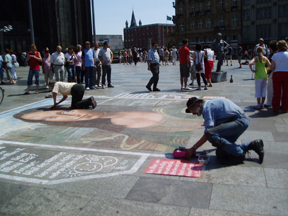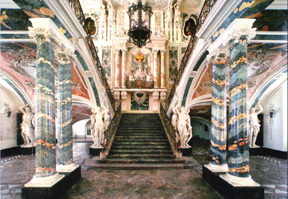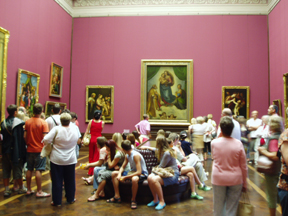By Cornelia Seckel
Instead of a lazy month in the garden and facing the enormous task of organizing the
abundance of “stuff” that accumulates in a household, we had the opportunity
to visit Germany, to visit friends, to see places we hadn’t seen before
and to do so without our heavy coats and warm clothing that accompany
us on trips usually made in January. It was not a tough decision especially
as we had some support from the German National Tourism Office and LTU Airlines.
It was the first time I had come in contact with LTU International
Airways, a company that has been steadily increasing its service from
numerous cities in the US to most countries in Europe (www.ltu.de). It was a comfortable flight, the usual services including meals &
movies. We landed in Düsseldorf and had made arrangements to stay at
the Steigenberger Parkhotel for our first night. What a luxurious hotel. The room spacious and elegant
as was the bathroom! Breakfast a virtual feast, service 5 star plus.
We checked in and cleaned up before heading out to explore. Düsseldorf
is a wealthy city with a famous shopping area along Königsalle —
certainly comparable to 5th Avenue, NYC or Worth Avenue in
Palm Beach FL. We walked into the old city and decided that since we
were to be there just one day we would walk and get impressions rather
than to visit any one of the many museums or take any excursions or
guided tours. We walked along the bank of the Rhine and saw many of
the old storehouses that have been rebuilt by several innovative architects
including Frank Gehry and Claude Vasconi. From the top of the Rhine
Tower, which has a restaurant that continually rotates 360 degrees,
we had a panoramic view of Düsseldorf and the surrounding area. What
we missed in Düsseldorf is the annual JazzRally (held at the
end of May) where 80 bands played at 30 different locations as well
as a Popcorn Festival.
The
next morning, our friends Heinrich & Christiane Jarczyk picked
us up and we were off to Cologne, a grand old city that we had visited
several times before. What I see as a growing trend here in the states
is also happening in the two cities I spent some time in — Berlin
and Cologne (as I saw it in Singapore several years ago): old warehouses
and factories being converted to live and work spaces for artists. In
most cities there is little opportunity for Opera, Concerts, or Theater
(as is true in NYC) during the summer. Musicians are in the countryside
and often taking part in the many Music Festivals throughout Germany
— Bach Festival in Leipzig, Rheingau Music Festival (one of Europe’s leading festivals, with more than 140 concerts taking
place in Frankfurt, Wiesbaden and Lorch), Opera Festival (est.
1875) in Munich, and the Beethoven Festival in Bonn.
We
visited the Cathedral, and each time I see it I am awed at the
size, the beauty, and the magnificence. >This is the greatest Gothic cathedral in Germany and has been
Cologne's most famous landmark for centuries. In August 1248, the cathedral
was built to house the relics of the Magi. Once the tallest building
in the world, Cologne Cathedral still boasts the world's largest church
façade.
Several days later we went to the Augustusburg
Palace in Brühl, the favored residence of the elector and archbishop
of Cologne, Clemens August of Wittelsbach. This rococo masterpiece built in 1728 and completed in
1768 has exquisite grounds and gardens, the ceremonial staircase, magnificent.
In 1984, UNESCO, considering
the Palace a comprehensive work of art in its architecture, ornamentation,
painting, and horticulture, added it to the cultural world heritage
list.
In Berlin we stayed with friends Jacky Sparkowsky and Jörg Iwan (after another one-night stay at a wonderful Steigenberger
Hotel) and here we did more exploring of the city with a one-day
side trip to Dresden.
One of the featured highlights for Germany this year is the exhibition
of masterpieces of 19th Century French Art from The Metropolitan
Museum of Art, NYC. 147 paintings by Ingres, Corot, Courbet, Puvis de
Chavannes, Manet, Degas, Pissarro, Monet, Cézanne, Gauguin, Bonnard and Matisse as
well as sculptures by Rodin, Degas and Maillol — are on display exclusively in The New National Gallery, the famous "temple
of light and glass" designed by Mies van der Rohe, which
houses a collection of 20th century European painting and sculpture.
Since I have easy access to the Met and the collections, I didn’t add
myself to the long line of waiting viewers.
Not too far from the Museum and the Brandenburg
Gate, is the Memorial to the Murdered Jews of Europe (www.stiftung-denkmal.de)
completed in 2005 and designed by Peter Eisenman. The grid pattern,
with 2,711 concrete stelae of different sizes weighing an average of
8 tons each, is arranged over 19,073 sq. meters. The stelae can be walked
through from all sides. The underground information center has information
on victims, places of extermination, today’s memorial sites, and a large
seminar room and bookshop. One room focuses on personal accounts written
by Jewish men and women during the persecution, another room focusing
on the fates of 15 Jewish families in different countries occupied by
the Nazis, and another room where names and biographies are read aloud
and projected on the 4 walls — it will take over 6 years to read
the entire database containing more than 3 million entries. Just before
exiting the information center there are several computers with a Holocaust
memorial database available for searching out individuals courtesy of Memorial Yad Vashem(www.yadvashem.org)
in Israel. As a Jew I was especially
moved by this memorial. It seemed to me that there was a constant flow
of people coming to the memorial, quietly walking through the stelae,
and then paying close attention to the information in the center. Germany
is filled with such reminders of the Nazi’s reign. What worse shape
the world would be in without these reminders.
It had been many years since we visited the Martin Gropius Building in Berlin. On the grounds as we were walking to the entrance we saw
a sculpture “4 lines in a T” (1985, collection of the Martin Gropius
Building) by George Rickey (1907-2002). George Rickey was a resident
of the Hudson Valley and it brought a smile to my face as I remembered
him from exhibits at Bard College. Even before we reached it,
we knew it was a “Rickey”, so familiar were his articulated forms slowly
moving in space. Again, because we wanted to cover as much ground as
possible we saved our resources by splitting up and seeing two different
exhibits while at the Gropius — I visited the Ré Soupault photography show while Raymond saw the Königs Gräber der Skythen,
a collection of gold and bronze artifacts recently unearthed from the
burial mounds of nomadic Scythian Kings near and around the Black Sea.
A city tour on one of the many different tour boats available gave us a delightful and different view of Berlin as a city that has the 2nd largest inland port in Germany. There are 650 bridges across rivers and canals and more navigable waterways than Venice, Amsterdam and Stockholm altogether. We saw castles, museums, culture centers, schools, government buildings, and learned more about the history of Berlin, now the capital of Germany. Right between the Spree and the Kupfergraben is Museum Island with the Bode Museum, the Pergamon Museum, the National Gallery and the New Museum and Old Museum all built to house the archeological collections and art of the 19th Century. Since we had previously visited most of the museums with our friend Heinrich Jarczyk some years ago, we decided to move along so we could cover more ground — enjoying, for example, a pleasant lunch nearby at Zum Nussbaum, one of Berlin’s oldest taverns built in the 1507.
And
of course, we didn’t see some of the other highlights the German Tourist
Office gave us information about — most specifically the opening
of Emigration Center in Hamburg. As I understand, visitors will
be able to get an impression of the conditions under which last century’s
European emigrants traveled across the Atlantic to start a new life
in America. There is a research project “Link to our roots”, a database that has all the passenger lists between 1850 & 1934.
www.ballinstadt.de. Still coming up in Germany during 2007 are the Wine
Festivals, the 200 year old Weimar Onion Market, Art
Forum in Berlin, Euro Scene, a contemporary Theater festival
in Leipzig, and of course the New Year’s Eve Party at the Brandenburg
Gate in Berlin. If any of my readers are able to get to some of
these events, I’d love to know about them.
|






 An
Archeological dig in the center of Dresden, Germany
An
Archeological dig in the center of Dresden, Germany